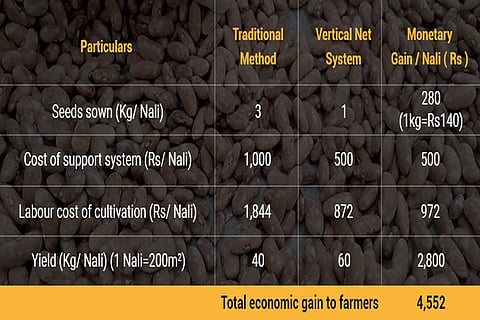Kidney beans (rajma) are consumed all over the world for their nutritional value. In India, rajma is grown traditionally during the kharif (summer and monsoon) season and is considered a high-value cash crop.
How Uttarakhand Rajma Growers Benefit Using This Method
Introduction of new methods, like ridge planting, use of vertical net trellis system instead of wooden stakes have helped farmers increase yield by 40%.
In Uttarakhand, several varieties are grown – like Munsyari Rajma from Pithoragarh), Chakrata Rajma in Dehradun, Harsil Rajma of Uttarkashi and Joshimath Rajma (Chamoli). These are distinctive in their quality, taste, and nutritional values.

But worms often cut the life of emerging young seedlings. Farmers often sow four or five seeds in the same place, which leads to overcrowding. The optimal plant-to-plant and line-to-line distance cannot be maintained.
These varieties are climbers and once the seedlings germinate, farmers need to harvest bamboo and other trees with straight trunks for use as stakes.
Since every plant needs to be staked, farmers often end up with thousands of wooden stakes on every patch of cultivated land. This practice not only adds many hours to the farmers’ already-busy season, but the forest ecosystem is harmed by the inordinate amount of wood that needs to be collected every season.
Also, due to the dense canopy, the lower leaves of the climbers turn yellow and fall off at an early stage. It also leads to fungal diseases.

The Tata Trusts, through its ‘Mission Pulses programme’, and initiated through the Himmotthan Society in 2018, helped introduce methods for farmers to earn better returns.
This programme began with seed production and selection so that farmers had access to quality seeds. Ridge planting was introduced to save germinating seedlings from cut worm.
Plant-to-plant distance at 30cm and line-to-line distance 120cm was scrupulously maintained and the seeds were treated with Trichoderma, a fungus that promotes plant growth.
The Himmotthan Society, which is also an associate organisation of Tata Trusts, introduced a new technique – a vertical net trellis system to provide support to the climbers instead of wooden stakes.
This allowed climbers have enough room to grow and proper access to light and air.
The results were soon apparent: the leaves remained green during development of the beans, the number of beans per plant increased, and they were free of fungal attack due to better aeration.
Farmers who adopted this system have reported an increase in yield of at least 40 percent.

Sati Devi, a widow hailing from Nirtoli village, Pithoragarh district, Uttarakhand, is one such farmer who benefitted from growing rajma using the new technique. A better produce has increased her income by Rs.20,000.
Similarly, Chandra Devi and her husband Yashwant Singh, living in Umdada village, Pithoragarh district of Uttarakhand, have added extra earning of Rs.15,000 with the new system.
Since farmers are no longer cutting wood to stake the climbers, use of the vertical net trellis helps to preserve the Himalayan forest ecosystem.
(All photograph and illustration courtesy Tata Trusts)